Linear Appraisal Scores


Jump to Structural Categories or Linear Traits or How do I use all this data?!
This is a LOT of information but please don't be intimidated. If you're participating in linear appraisal, all you have to do is walk your goat in front of the appraiser. This page is an explanation of the scoring that happens. Most of it is taken straight from the 2021 ADGA SOP for Linear Appraisal - I just formatted it for easier reading and added photos. Enjoy!
Not sure what all the technical terms for goat anatomy mean? AGS has a helpful diagram!
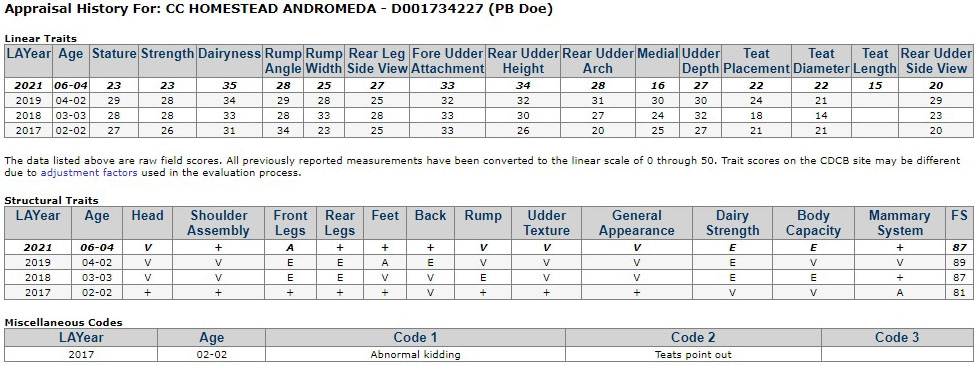
Note that "V" and "+" each only represent a spread of 5 points while all other categories are 10 points.
Changes:
Scores for CC Homestead Andromeda (newest to oldest):

That's subjective! Scores generally improve with age. A first freshener is like an awkward teenager - she could score 79 as a yearling and 89 at five years old. Don't judge young goats too harshly - they're still growing!
These scores are out of 100. The highest score a Nigerian Dwarf has earned is 93 and there are only three does who have earned that score.
Personally, I ignore yearling scores. Most of them will score somewhere in the 70s just because they're immature. When they're 2-3 years old, I expect scores in the low to mid 80s. At 4-5 years old I want to see mid to high 80s. Anything in the 90s is cause for celebration!
An attractive framework with femininity (masculinity in bucks), strength, upstandingness, length, and smoothness of blending throughout that create an impressive style and graceful walk.
To paraphrase: Everything blends together well and looks "correct". More specifically: withers taller than hips, wide nose, front legs tight against body, deep and wide chest, straight and level back, wide hips, level rump, straight legs, tight toes, and hooves level from toe to heel.
Angularity and openness with strong yet refined and clean bone structure, showing enough substance, but with freedom from coarseness and with evidence of milking ability giving due regard to stage of lactation (of breeding season in bucks).
To paraphrase: Everything that sets dairy goats apart from meat goats. More specifically: long and lean neck, noticeable withers, flat ribs, no excess fat, curved thighs that give room for an udder, and thin skin.
Relatively large in proportion in size, age, and period of lactation of animal (of breeding season for bucks), providing ample capacity, strength, and vigor.
To paraphrase: Having enough space in the body for healthy, hard-working organs. More specifically: deep and wide chest with a deep and long body.
Strongly attached, elastic, well-balanced with adequate capacity, quality, ease of milking, and indicating heavy milk production over a long period of usefulness.
To paraphrase: A well-balanced, well-attached udder that can hold a lot of milk and is easy to milk. More specifically: strong medial ligament, strong attachments, wide and well-rounded udder, and teats that point straight down.
Can you see why Andromeda earned these scores?
6 years old
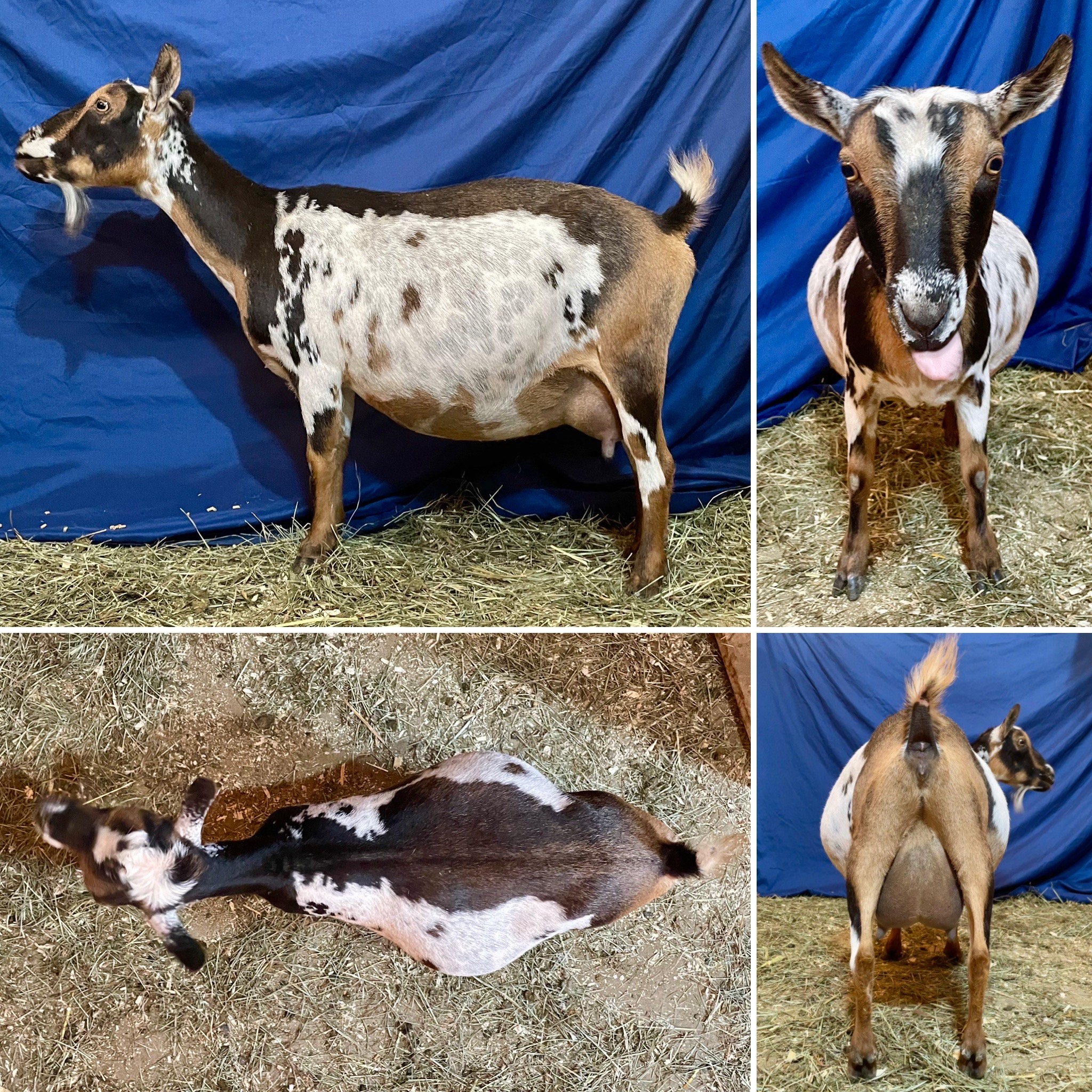
4 years old
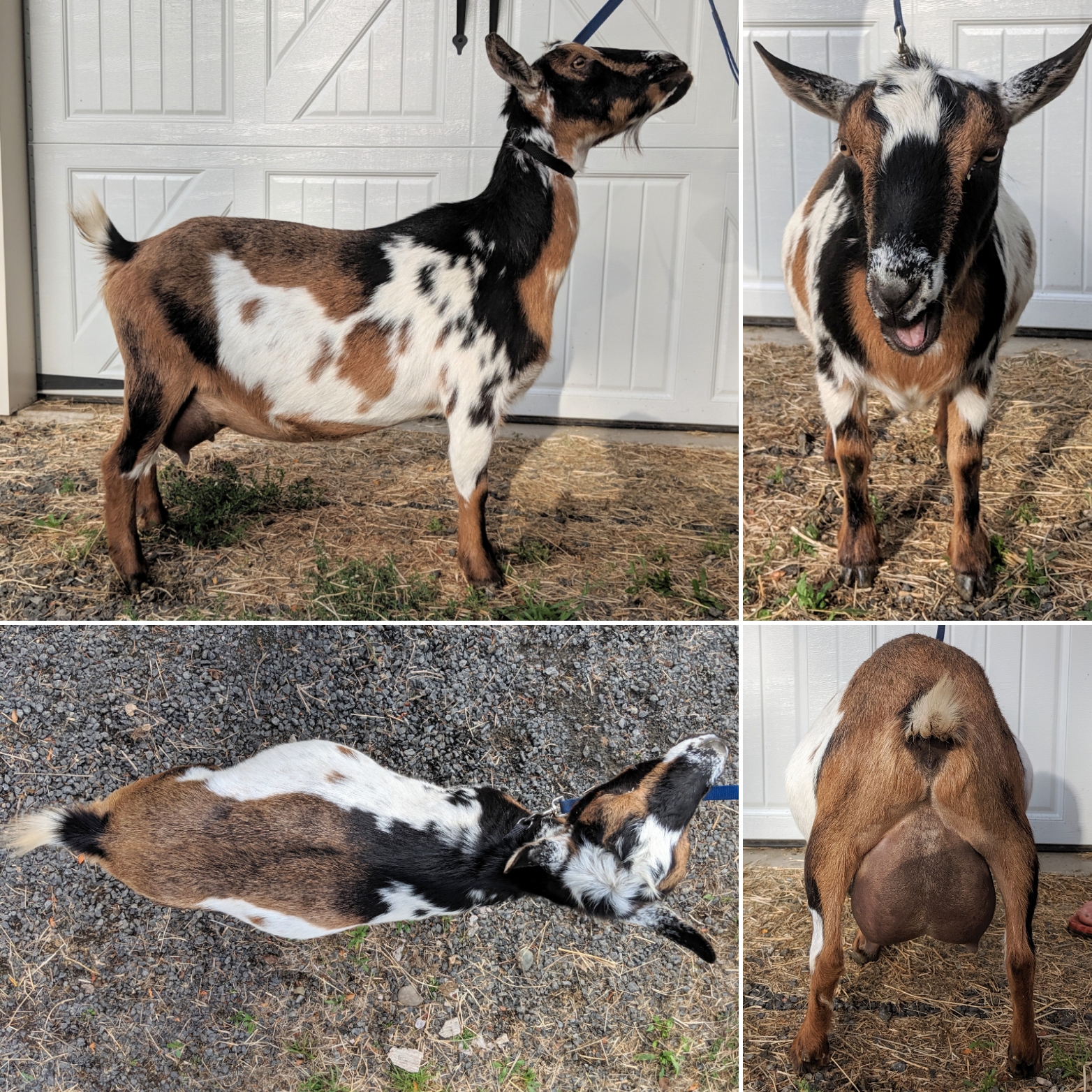
3 years old
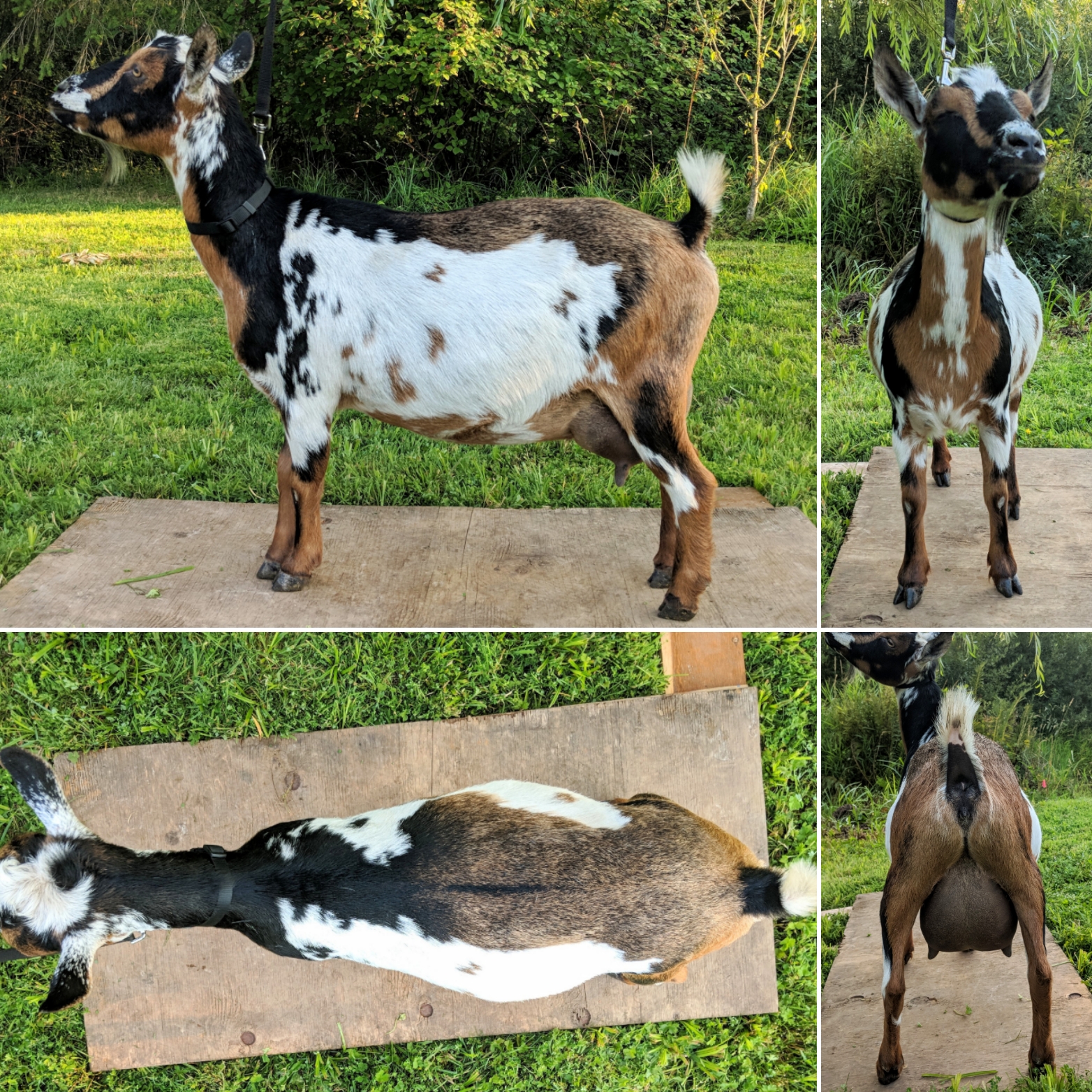
2 years old
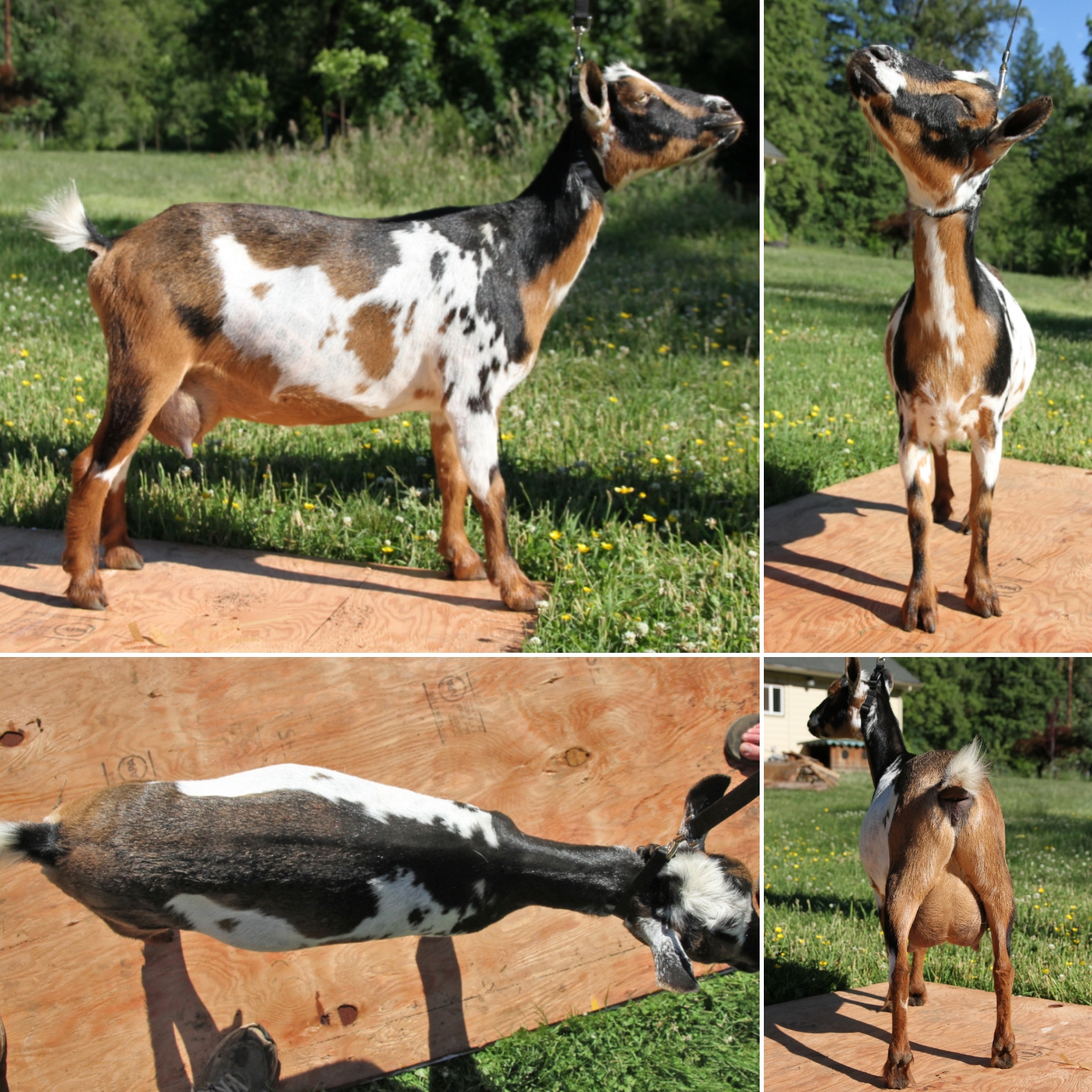
These use the same letter/symbol scores as the final score.
Scores for CC Homestead Andromeda (see above for photos):

These are the same descriptions as found in the final score categories, just broken out so you can see the individual scores for these parts of the body.
These are scored 0-50 with both 0 and 50 being extremes. Higher scores are not better than lower scores; "ideal" is somewhere in the middle. There is no direct relationship between these scores and the final score. There is more than one way to put together a good looking goat!
Scores for CC Homestead Andromeda (see above for photos):

This is a straight conversion from height in inches.
Nigerian Dwarfs are coded as overheight (miscellaneous code 82) if a doe is over 22.5" or a buck is over 23.5".
*New in 2022: Only goats with a score of 93 or greater or goats who are over height will have an exact measurement recorded in inches.
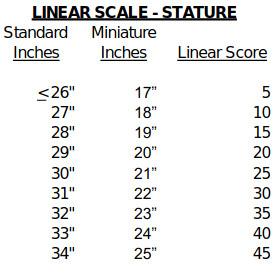
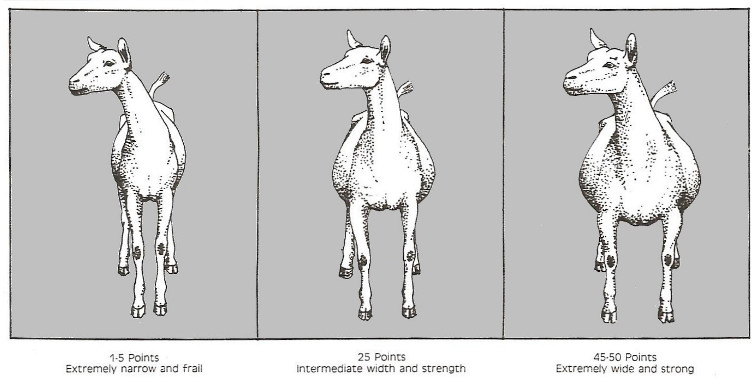
The width and depth of the chest, the width of the muzzle, and the substance of bone in the goat’s front end are used to determine the strength of the goat. The range for this trait is from extremely narrow and frail to extremely wide and strong. Width and strength is associated with the likelihood the goat can sustain high production and good general health. Strength is measured from weakness (less than 20 points) to strength (more than 30 points). The intermediate range is from 20 to 30 points.
*New in 2022: This trait will be evaluated using chest width and depth only.
To paraphrase: Narrow goats score lower, wide goats score higher.
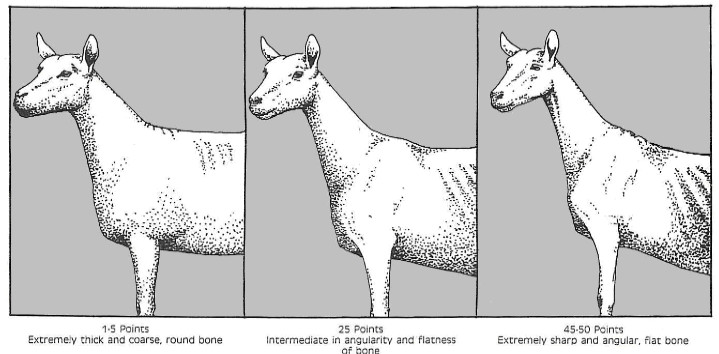
When evaluating Dairyness, the appraiser considers length, cleanness and flatness of bone, length and leanness of neck, definition and sharpness of withers, degree of fleshing, femininity and refinement, and fineness and texture of skin. Dairyness is measured from coarseness (which is assigned 10 points or less) to extreme sharpness (which is assigned 40 or more points).
To paraphrase: Coarse, rounded looking goats score lower, sharp, angular looking goats score higher.
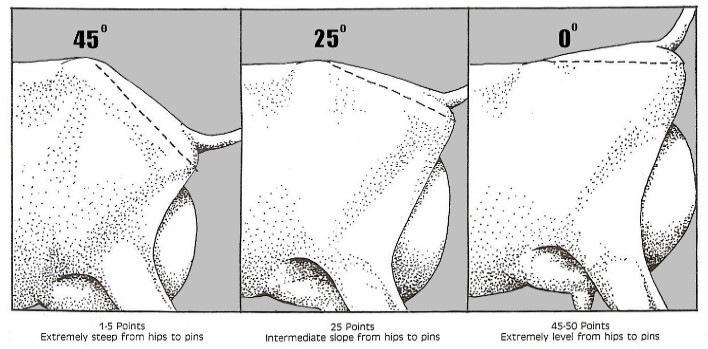
The angle of the rump or pelvis from hips to pins has a direct bearing on the reproductive performance of a goat because it influences the ease of kidding and drainage of the reproductive tract. The angle of the rump is also related to the length of udder from fore to rear, strength of fore udder attachment, and udder depth. Observing the goat on the move from the side, the appraiser evaluates the angle of the rump from the hips to the pins. Rump angle is measured from steepness, which is assigned 20 or less points, to levelness, which is assigned 30 or more points. Rumps intermediate in slope (30° to 20°) are assigned 20 to 30 points. Each difference of 5° in the rump angle, plus or minus, results in a difference in the score of 5 points. A rump angle of 50° or more is assigned 1 point.
To paraphrase: Steep rumps score lower, level rumps score higher.
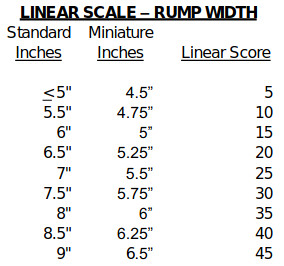
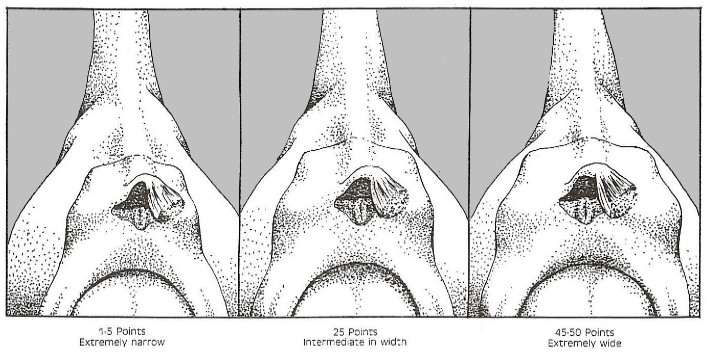
The width of the rump is important for three reasons. The width of the rump relates to kidding ease; the wider the rump or pelvis, the easier the delivery of kids. The width of the rump also is an indicator of general body width throughout, as well as the potential for udder width. Rump width is determined as the width between the thurls; that is, the width of the pelvic girdle. An extremely narrow rump (5” or less) is assigned 5 points or less, a rump of intermediate width (7”) is assigned 25 points, and an extremely wide rump (9” or more) is assigned 45 or more points. Rump Width in Miniature breeds is recorded in inches to the nearest ¼ inch as data is collected to determine the biological range. Rump Width in the Optional Young Stock program will be recorded in actual inches, rather than assigning a point value. The appraiser determines the width of the pelvic region from thurl to thurl. Each 1’ difference in rump width, plus or minus, results in a difference in the score of 10 points.
To paraphrase: Narrow rumps score lower, wide rumps score higher.
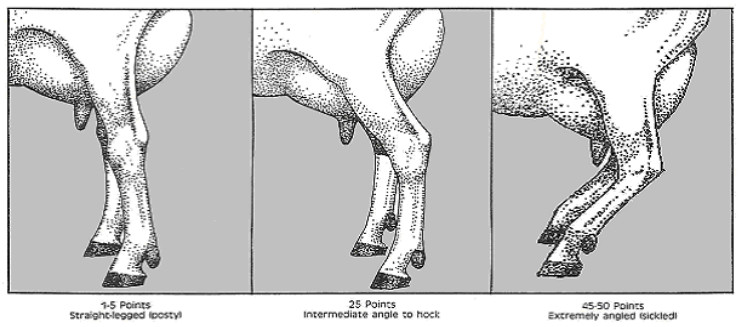
This trait relates to the durability of the legs and feet, as reflected by the degree of angle of the hock. By looking at the goat from the side, the appraiser can evaluate the degree of angle to the rear leg. The less angle or postier the leg, the lower the score. An intermediate angle in the hock relates to the midpoint of the range. Legs that tend toward straightness (or postiness) are assigned 20 or less points. Legs that tend toward greater angulation are assigned 30 or more points.
To paraphrase: Straight legs (posty) score lower, angled legs (sickled) score higher.
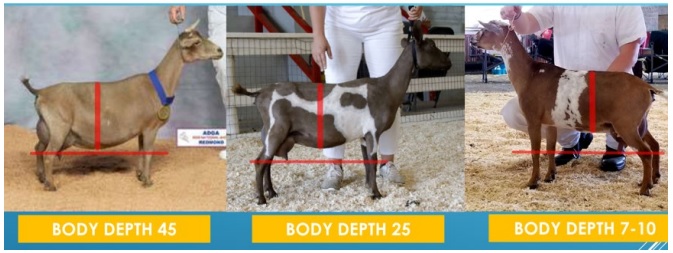
This trait will be evaluated from the top of the spine to the bottom of the barrel at the point of the last rib. The vertical red lines in the pictures represent where the appraiser will evaluate this trait. The red horizontal line is a point of reference through the hock.
To paraphrase: Thin bodies score lower, deep bodies score higher.
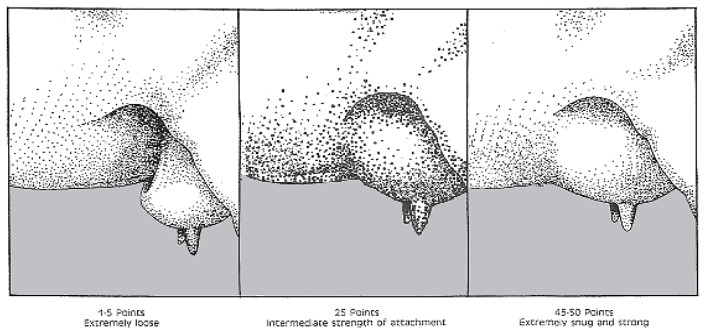
In evaluating the fore udder attachment, the appraiser looks at the strength of the attachment of the lateral ligaments as they extend forward and laterally to the body wall. The scale ranges from an extremely loose attachment (5 points or less) to an extremely snug and strong attachment. Fore udders with lateral ligaments that are intermediate in strength and tightness are assigned 25 points.
To paraphrase: Loose attachments (pocket) score lower, strong attachments score higher.
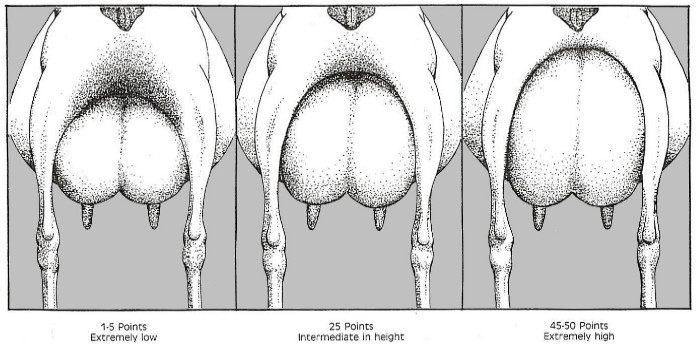
The height of the rear udder attachment is an indication of the goat’s potential capacity for milk, in that it affects udder capacity, and of the udder’s ability to hold its shape and position through repeated lactations. Rear udder height is scored in proportion to the goat. An extremely low attachment is assigned 5 or less points; udder attachments of intermediate heights are assigned 25 points; while an extremely high attachment is assigned 45 or more points. Differences in hair and issue texture between the rear udder and escutcheon are used as aids in determining the point of attachment. This trait is not recorded in bucks. This trait is called “Escutcheon Height” in the Optional Young Stock program, and will be recorded in actual inches rather than a point value.
To paraphrase: Lots of space between the top of the udder and the vulva scores lower, little space scores higher.
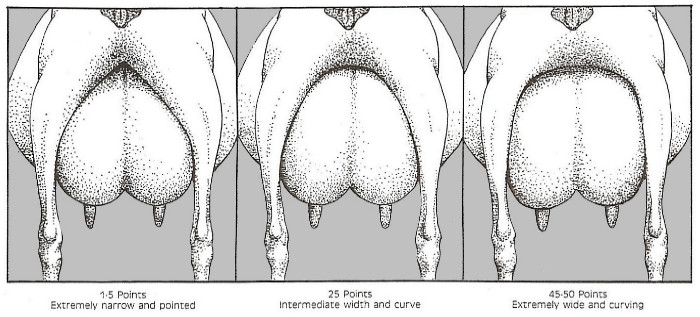
The evaluation of rear udder arch considers both the width and the shape of the attachment of the rear udder. The rear udder arch is an indication of the goat’s potential capacity for milk, in that the width and shape of the rear udder attachment affects udder capacity, and the udder’s ability to hold its shape and position through repeated lactations. An extremely narrow and pointed rear udder arch is assigned 5 or less points, a rear udder intermediate in width and arch is assigned 25 points, and a rear udder that is extremely wide and arched assigned 45 or more points. Rear udder arch is evaluated at the same spot as rear udder height. Differences in hair and skin texture between the udder and the escutcheon are used to determine the point of attachment. This trait is called Escutcheon Arch in the Optional Young Stock program.
To paraphrase: A narrow, pointed arch scores lower, a wide, rounded arch scores higher.
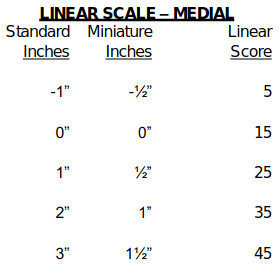
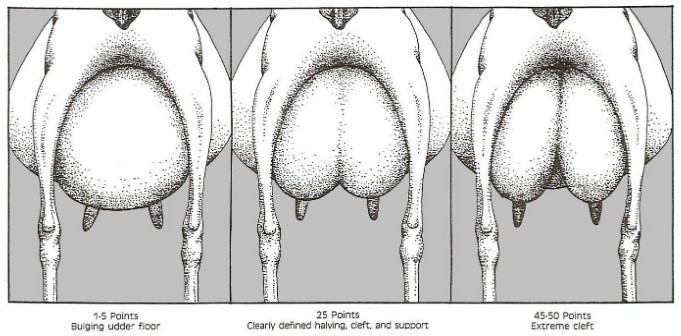
The medial suspensory ligament is the primary support for the udder. A strong medial suspensory ligament affects the goat’s production potential by keeping the teats in place and the udder elevated, reducing the potential for injury. An udder with a weak medial suspensory ligament, resulting in a negative cleft or bulge in the floor of the udder, is assigned 5 or less points. An udder with clearly define halving and support (1” cleft) is assigned 25 points, and an udder with an extreme cleft (3” or more) is assigned 45 or more points. The assignment of an udder support score is based on the appraiser’s evaluation of the amount of cleft in the floor of the udder attributable to the medial suspensory ligament. A difference of 1” in the amount of cleft, plus or minus, results in a difference of 10 points.
To paraphrase: An udder without much definition scores lower, an udder clearly defined in two halves scores higher.
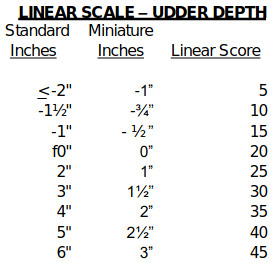
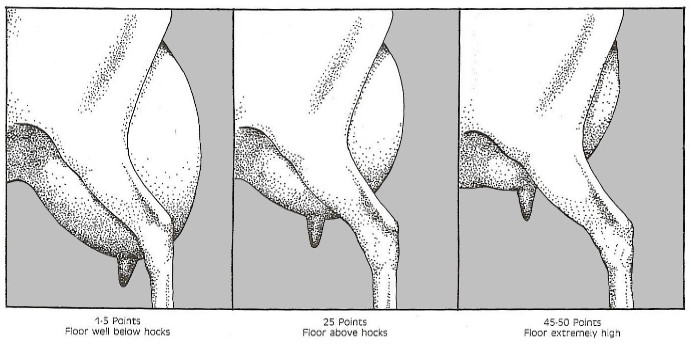
The depth of the udder is measure relative to the hocks. While some degree of udder depth is necessary for capacity, an udder that is extremely deep is more susceptible to injury and mastitis infection. Udder depth is evaluated as the vertical distance between the floor of the udder and the point of the hock, when the rear leg is set in a normal position under the animal. A deep udder that is at least 2” below the hocks is assigned 5 or less points, an udder that is intermediate in depth (2” above the hocks) is assigned 25 points, and a shallow udder that is extremely high above the hocks (6” or more) is assigned 45 or more points. An udder that is 3” or more below the hock is assigned 1 point. Proportional adjustment is made for miniature breeds.
To paraphrase: An udder floor below the hocks scores lower, an udder floor above the hocks scores higher.
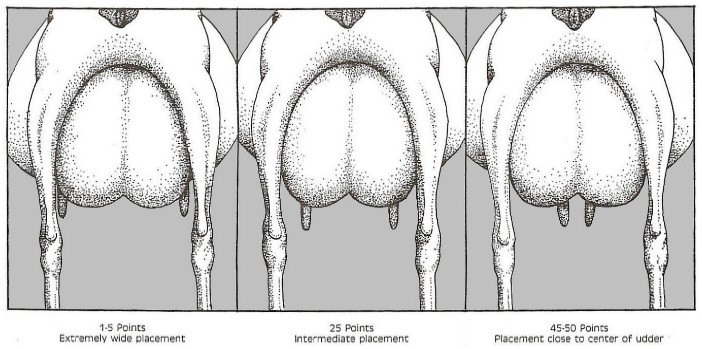
Teat placement, as viewed from the rear, is related to both ease of milking and susceptibility to injury. Teat placement is measured from being on the outside third of the udder half (less than 25 points) to being less than two-thirds of the way out (more than 25 points). Teats that are located one-third of the way out on the udder half are assigned 45 points; teats that are less than one-third of the way out are assigned more than 45 points. Position is determined by the center of the teat at the point where the teat attaches to the udder.
To paraphrase: Teats near the outside of the udder score lower, teats near the center of the udder score higher.
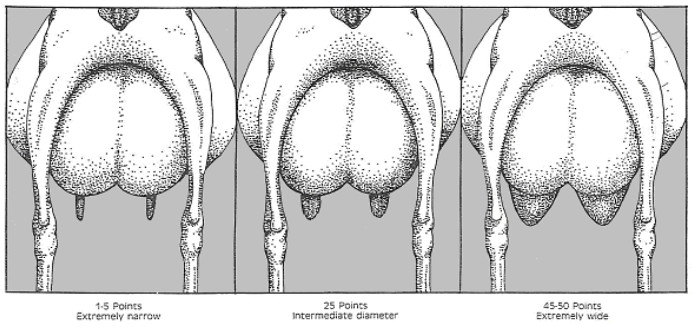
Teat diameter is evaluated as the diameter of the teat at its base where it meets the udder, as viewed from the rear. Both delineation of the teat from the udder and ease of milking are reflected in the evaluation of teat diameter. A very narrow teat, ½” (standard) ¼” (miniature) or less in diameter, is assigned 5 or less points; a teat that is intermediate in diameter 1½” (standard) ¾ ” (miniature) is assigned 25 points; and a teat that is very wider 2½” (standard) 1¼” (miniature) or more in diameter, is assigned 45 or more points. A difference of ½” (standard) ¼” (miniature) in teat diameter, plus or minus, results in a difference of 10 points.
To paraphrase: Narrow teats score lower, wide teats score higher.
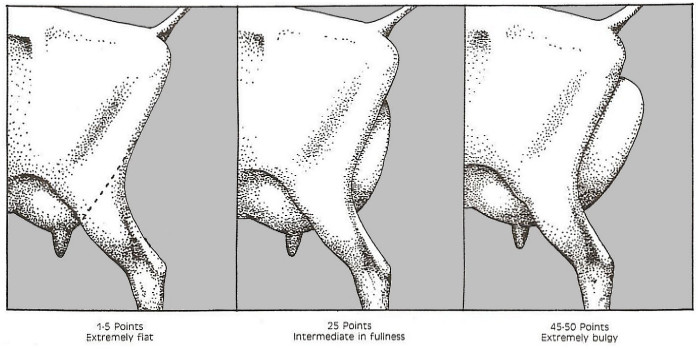
Rear udder, side view, is evaluated as the shape of the rear udder as it extends behind the rear leg when a goat is standing with her rear legs squarely beneath her. The shape of the rear udder from the teats to the rear udder attachment is an indication of the capacity of the rear udder for milk. Extremely flat rear udders, with little capacity, are assigned 5 or less points; rear udders with intermediate fullness are assigned 25 points; and rear udders that are extremely bulgy or protruding are assigned 45 or more points.
To paraphrase: Flat udders score lower, bulging udders score higher.
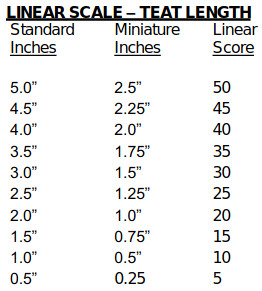
To paraphrase: Short teats score lower, long teats score higher.
If your herd has been appraised, their scores are a fantastic way to see their conformational strengths and weaknesses. This can help you decide what to look for in any new additions.
Andromeda's lowest score is in mammary. When choosing a buck to breed to her, I will look for one whose dam and sire's dam both scored V or E in mammary.
When Andromeda was younger her teats pointed out and I've noticed the same in all of her daughters. It has improved with age and the development of her medial suspensory ligament but I spent years being annoyed with their position while hand milking. Andromeda and her daughters should be bred to a buck whose dam and sire's dam have a higher score in the linear trait of medial suspensory ligament.